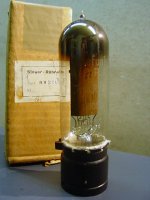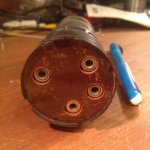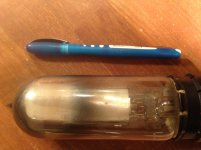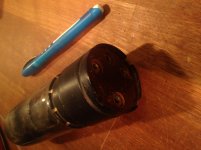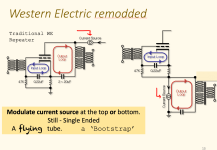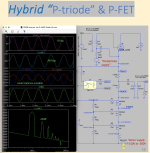I just found a set of three very old TELEFUNKEN RV218(V) triodes, N.O.S and still boxed ! These are big pre-war direct heated power triodes with a max.plate dissipation of 24 W and 440 V max. plate voltage. Low µ (7) and 3.5 K plate resistance , 2.000 µmhos transconductance.
Does anybody here have any experience with this tube, and how does it compare with other DH triodes in the same power range (50, PX25 , 300B , etc..) in a S.E amp configuration ? I'm still hesitating building a S.E amp with these or selling them to some antique-tube collectors. They look very nice but I only have 3 pieces and they will be nearly impossible to replace in the future. Any thoughts ?
Does anybody here have any experience with this tube, and how does it compare with other DH triodes in the same power range (50, PX25 , 300B , etc..) in a S.E amp configuration ? I'm still hesitating building a S.E amp with these or selling them to some antique-tube collectors. They look very nice but I only have 3 pieces and they will be nearly impossible to replace in the future. Any thoughts ?
Attachments
Last edited:
They sound like a cross between a globe 50 and a 10Y. They have the seductive smoothness of the 50, but the detail of the 10Y. One of the better DHT out there. I heard these in a Larry Moore 10 Squared amp where they were used as the output tube. We listened to VT-52, 50, 801A, 10, 10Y and the RV-218. The RV-218 beat them all hands down. Output transformer was 5K Tango unit wired to reflect 10K to the tubes. I think the operation point was around 425V at 25mA-30mA.
They sound like a cross between a globe 50 and a 10Y. They have the seductive smoothness of the 50, but the detail of the 10Y. One of the better DHT out there. I heard these in a Larry Moore 10 Squared amp where they were used as the output tube. We listened to VT-52, 50, 801A, 10, 10Y and the RV-218. The RV-218 beat them all hands down. Output transformer was 5K Tango unit wired to reflect 10K to the tubes. I think the operation point was around 425V at 25mA-30mA.
Thank you for your listening impressions and encouraging comments: if only slightly better than a 50 or 10Y , the RV218 would be already a great tube... looks it's even much better. Could you recommend any currently available output transformer ?
Hi!
The Lundahl LL2735B/30mA would be perfect for these...
You can contact me via PN if you are interested in these. I have some pairs left over
Thomas
The Lundahl LL2735B/30mA would be perfect for these...
You can contact me via PN if you are interested in these. I have some pairs left over
Thomas
Any high quality transformer in the 7K to 10K range that is rated for 25mA to 40mA of current. While the LL2735B looks like it would work well with the RV-218's plate impedance, I'm afraid that it would make it sound too dark. The RV-218 starts to sound a little too dark if you start to go over 10K. I would not recommend a load over 10K, maybe 12K at the very most. The RV-218 sounds more lively with a 5K load, but loses some bass control. The 7K to 10K range seems to be the sweet spot for this tube.
Hi!
I don't see how a certain value of the load impedance should make a tube sound dark. The transformer alone does not provide any load impedance at all. Only in conjunction with a connected speaker you get your impedance. Now your speaker impedance can be anywhere, even if the speaker manufacturer states a nominal impedance of say 8 Ohm, the actual impedance can deviate largely from that and with it the load the tube sees.
At 7k the amp will provede a very low dampling factor of 2 Which means any impedance variations in the speaker will color the sound. With such a damping factor the speaker impedance should be linearized. If it comes to coloration I'd suspect it is the relation between amp output impedance to the impedance variation of the speaker.
Best regards
Thomas
I don't see how a certain value of the load impedance should make a tube sound dark. The transformer alone does not provide any load impedance at all. Only in conjunction with a connected speaker you get your impedance. Now your speaker impedance can be anywhere, even if the speaker manufacturer states a nominal impedance of say 8 Ohm, the actual impedance can deviate largely from that and with it the load the tube sees.
At 7k the amp will provede a very low dampling factor of 2 Which means any impedance variations in the speaker will color the sound. With such a damping factor the speaker impedance should be linearized. If it comes to coloration I'd suspect it is the relation between amp output impedance to the impedance variation of the speaker.
Best regards
Thomas
I believe what I heard was related to a lower damping factor made for less speaker control and a more lively reproduction of the music. With relatively higher reflected impedance, more speaker control took on a more controlled and darker sound.
Hi!
Yes, that could be the case. In my experience, different speakers react differently to damping factor. So with other speakers the higher impedance (higher winding ratio) might sound better
Thomas
Yes, that could be the case. In my experience, different speakers react differently to damping factor. So with other speakers the higher impedance (higher winding ratio) might sound better
Thomas
Hi!
I don't see how a certain value of the load impedance should make a tube sound dark. The transformer alone does not provide any load impedance at all. Only in conjunction with a connected speaker you get your impedance. Now your speaker impedance can be anywhere, even if the speaker manufacturer states a nominal impedance of say 8 Ohm, the actual impedance can deviate largely from that and with it the load the tube sees.
At 7k the amp will provede a very low dampling factor of 2 Which means any impedance variations in the speaker will color the sound. With such a damping factor the speaker impedance should be linearized. If it comes to coloration I'd suspect it is the relation between amp output impedance to the impedance variation of the speaker.
Best regards
Thomas
Agree! Agree! Agree!
I have wound numerous interstage and output transformers, Thomas, you are sooo right!
Greetings from Athens.
Peter
I just got a pair of these RV218 III Telefunkens.
Now the RV218, RV238, RV258 base is female (while all other tubes I know on this small planet are male).
Is there a socket for that or do I have to make one with wires and bananas and clamp the tube? Not that replaceable.
Just also bought a 7K 25/30mA output transformer. 🙂
And I will use these instead of a 10Y long plate tube that I ran conservatively at 360Va, and Vg -30V and some 20mA for decades.
Now the RV218, RV238, RV258 base is female (while all other tubes I know on this small planet are male).
Is there a socket for that or do I have to make one with wires and bananas and clamp the tube? Not that replaceable.
Just also bought a 7K 25/30mA output transformer. 🙂
Attachments
Yes, 4 mm banana plugs will fit into the socket connectors. Use only the metal innards of four high quality plugs, arrange them at the edges of a kite of proper dimensions, and fix them on a sheet of heat resistive insulation material, such as phenolic board or similar.
Don't clamp the tubes, 'cause you might or will damage them! All of them are from the 1920ies, utterly scarce and hence vertiginously pricey!
Best regards!
Btw, some decades ago I've found a Telefunken RV 258 II which features the same socket and looks quite amazing. Unfortunately I've got only one tube, otherwise I would have built a stereophonic DHT amplifier yet. And be aware of that asbestos between the glass envelope and the socket skirt!
Don't clamp the tubes, 'cause you might or will damage them! All of them are from the 1920ies, utterly scarce and hence vertiginously pricey!
Best regards!
Btw, some decades ago I've found a Telefunken RV 258 II which features the same socket and looks quite amazing. Unfortunately I've got only one tube, otherwise I would have built a stereophonic DHT amplifier yet. And be aware of that asbestos between the glass envelope and the socket skirt!
Yes, 4 mm banana plugs will fit into the socket connectors. Use only the metal innards of four high quality plugs, arrange them at the edges of a kite of proper dimensions, and fix them on a sheet of heat resistive insulation material, such as phenolic board or similar.
Don't clamp the tubes, 'cause you might or will damage them! All of them are from the 1920ies, utterly scarce and hence vertiginously pricey!
Best regards!
Btw, some decades ago I've found a Telefunken RV 258 II which features the same socket and looks quite amazing. Unfortunately I've got only one tube, otherwise I would have built a stereophonic DHT amplifier yet. And be aware of that asbestos between the glass envelope and the socket skirt!
Thanks,
so my plans are: insert the plugs, attach then on the back to a sheet of phenolic with screws on the copper side, attach the phenol plate to the chassis.
And yes, one tube has the asbestos weave sticking out. it is the same type of asbestos fibres I had in heaters for lab glass when I was at college. It is brittle. Better not get it to mecome dust and fly around. The man who had owned them was a director at Philips tube factories, and actually got lung cancer. . . 😱
Does the base get hotter than a standard 300B? I have the 300B at 360V/72mA and the base and globe are not that hot; the RV218 should be 'cooler' at 360V because I will go for something like 40-50mA.
- I expect slightly more than the standard output of the 300B. (With my 10Y I got @ 15mA / 10K? almost 4 watt from the 10Y). The 300B is inefficient, I have mine now at 4K6 and it is significantly improving in sound and output.
There are allways some Telefunken RV 258 II on Ebay but they are coated with a special metal glaze, Inobtainium. 🙄
The better 4 mm bananas, e.g. those from Hirschmann, have threaded back ends to screw the isolating sleeve onto. The threads are standard metric M5. So you might want to cut threads into the (phenolic) boards, screw the naked plugs in and terminate by use the small screws.
Best regards!
Best regards!
I have thought about these:
They have a back end screw that I can use to attach it to a piece of phenolic plate.
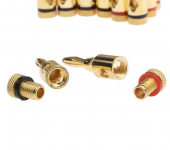
The front side is like the 'chinese nakamichi plugs' that I have. They are attached on the front to the main hose of the plug, not sliding.
Better of course are older plugs from a lab I have, with some twenty independent springs that push outwards.
But it means cannibalising some measurement leads
They have a back end screw that I can use to attach it to a piece of phenolic plate.

The front side is like the 'chinese nakamichi plugs' that I have. They are attached on the front to the main hose of the plug, not sliding.
Better of course are older plugs from a lab I have, with some twenty independent springs that push outwards.
But it means cannibalising some measurement leads

And what does an RV218 look like underneath that 1920's socket, that pre-UX4 bayonet?
Here with an RV258 with the same foot, this is what some guy did: dissect the tube foot.
And then it is like Humpty Dumpty, nothing could be put together again
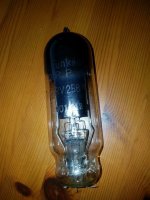
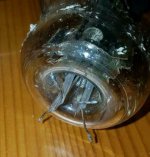
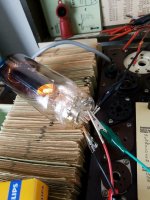
This one is for sale in this very bad shape in a Dutch classified site, for $ 65 right now. Taking away the bottom took away 80% of the value
Here with an RV258 with the same foot, this is what some guy did: dissect the tube foot.
And then it is like Humpty Dumpty, nothing could be put together again



This one is for sale in this very bad shape in a Dutch classified site, for $ 65 right now. Taking away the bottom took away 80% of the value
I still don't have the proper output transformers. A pity. I now have 'Maggies'. Changes all plans a lot.
These were my latest incarnations to use them just in another way . .
Pondering on how to use 'single ended' in another way. By CCS/choke loading like Western Electric hsowed us to do it.
Or by going along the path shown by Nelson Pass.
Whatever the solution, a large negative can be easily made (the transformers intended fot a tube rectifier can be used also for negative). A very large positive is harder (riskier).
😎
Pondering on how to use 'single ended' in another way. By CCS/choke loading like Western Electric hsowed us to do it.
Or by going along the path shown by Nelson Pass.
Whatever the solution, a large negative can be easily made (the transformers intended fot a tube rectifier can be used also for negative). A very large positive is harder (riskier).
😎
Attachments
- Home
- Amplifiers
- Tubes / Valves
- Telefunken RV218 power triode
